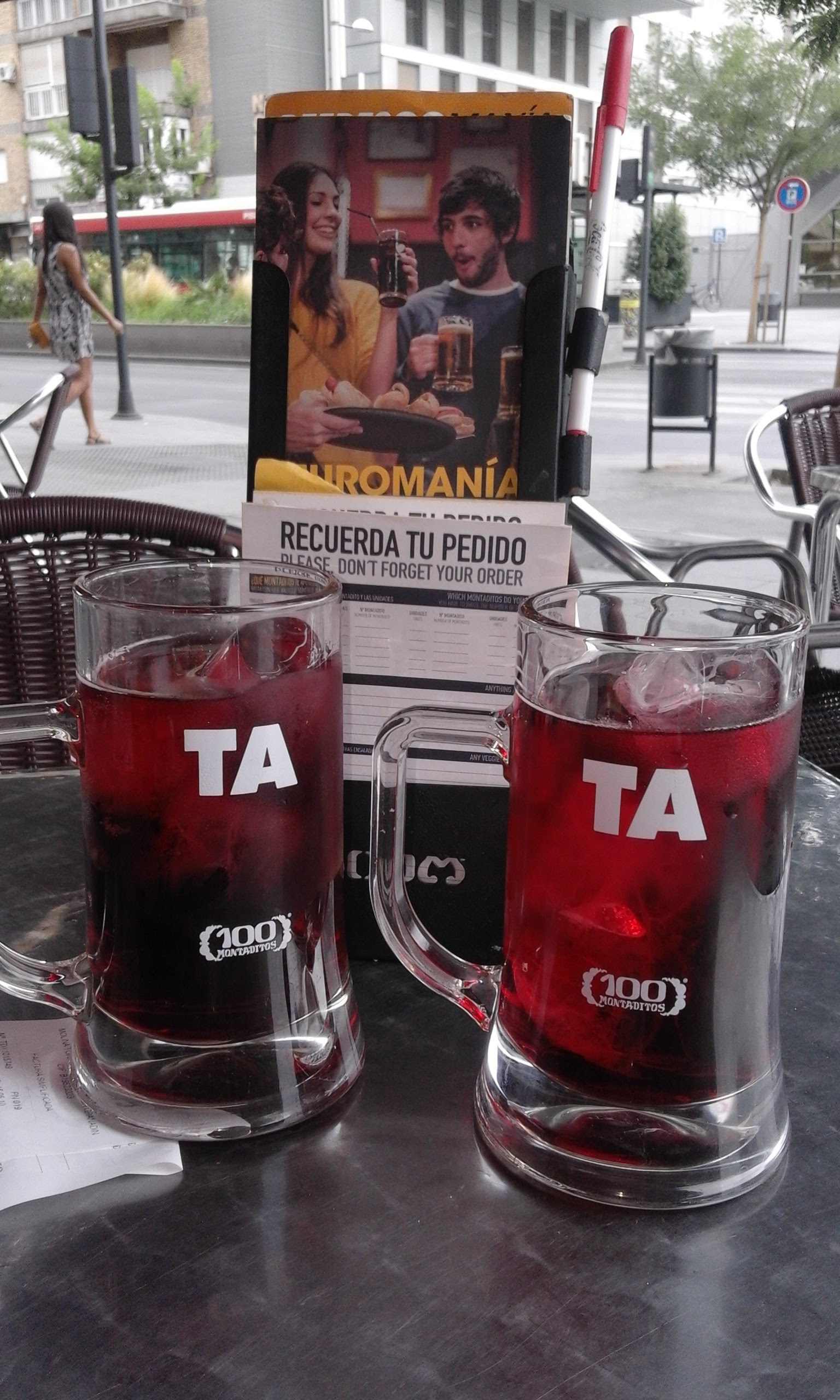
Choosing Your Spanish Wine and Wine-based Drinks
 Dear Alan,
Dear Alan,
To continue our focus on delicious beverages you can find here in Spain, today I’d like to hone in on Spanish wine and other wine-based drinks. I personally had never drunk wine before studying abroad in Alicante, but by the end of my semester there I had been introduced to a plethora of new favorites. From the classic chilled white wines and room-temperature reds to the jarras de sangria from Lizarran and enormous tintos de verano on tap at 100 Montaditos, my original experience with these drinks was not the most sophisticated, but I’ve learned a lot about what to order and what I like most over the years.
If you’re here in Spain and looking to take part in the wine-drinking scene but don’t know where to start, I’ve compiled a list of the main three options, when you’ll see others drinking them, and how I personally prefer to order each. Hope it serves you well!
Wine
Wine is definitely a common go-to for nights out—or even nights in—here in Spain! Because wine is made domestically it’s actually quite affordable and therefore it’s not unusual for Spaniards to enjoy a few glasses during an everyday lunch, dinner, or tapas outing. I personally prefer red wine and also think it is the slightly more popular choice, but you will always be able to find white as well!
Red wine (Vino tinto): When ordering vino tinto by the glass, you are likely to be served a Rioja wine if you don’t specify otherwise. This is definitely the most famous Spanish wine internationally-speaking, but Ribera is my personal favorite. Both of these wines tend to be made from tempranillo grapes, but get their names from the regions they’re grown in (La Rioja and Ribera del Duero, respectively).
Pro-Tip: While any wine connoisseur will tell you that red wine is meant to be served at room temperature, do not be surprised if your vino tinto is served chilled, especially on a hot summer day. If you are particularly picky about this, be sure to specify your temperature preference when you order. I personally get annoyed when served a chilled Ribera during the winter, but have learned to welcome it in the Spanish heat.
White wine (Vino blanco): Spaniards also love their vino blanco and you’re likely to be served a Rueda unless otherwise specified. Rueda is generally made from a verdejo grape blend, grown in various regions like Valladolid, Segovia, and Avila. However, depending on the region you may have the option to choose something more unique like the Txakoli produced in the Basque region.
Pro-Tip: If you don’t know yet know what kind of wine you like, start out ordering the vino de la casa (house wine), which is also what you will be served unless you order specifically off a list. That way you can find out what kind it is once you already know how much you enjoyed it. Don’t be afraid to inquire about which options would be sweeter, drier, fruitier, etc for your next glass if you need to.
![]() Further resources: Of course, there’s much more to be said about Spanish wine! You can read our full introduction to Spanish wine here as well as check out Serious Eats’ more extensive guide here. And if you’re really feeling like you really want to dive in, take a listen to the Spanish Wine Experience podcast!
Further resources: Of course, there’s much more to be said about Spanish wine! You can read our full introduction to Spanish wine here as well as check out Serious Eats’ more extensive guide here. And if you’re really feeling like you really want to dive in, take a listen to the Spanish Wine Experience podcast!
Tinto de Verano
 Tinto de verano or, literally, “summer wine” is actually a popular choice year-long. I even find that this is a good choice when you’re not planning to drink, but end up doing so anyways because it’s a very low alcohol content option compared to the other wine-based drinks. This is a go-to on a sunny day when you’re enjoying tapas outdoors as it’s light and refreshing. Tinto de verano is also a very affordable option (often the same cost as a beer or soft drink whereas wine tends to be a few euros more) and therefore a more common choice for Spaniards than sangria.
Tinto de verano or, literally, “summer wine” is actually a popular choice year-long. I even find that this is a good choice when you’re not planning to drink, but end up doing so anyways because it’s a very low alcohol content option compared to the other wine-based drinks. This is a go-to on a sunny day when you’re enjoying tapas outdoors as it’s light and refreshing. Tinto de verano is also a very affordable option (often the same cost as a beer or soft drink whereas wine tends to be a few euros more) and therefore a more common choice for Spaniards than sangria.
With lemon (con limón): Unless you order your tinto de verano otherwise, you’ll be served a beverage of red wine mixed with a lemon-flavored soft drink (usually Fanta or Casera). This results is a very sweet, easy to drink beverage.
With ‘white’ (con blanca): On the other hand, you can order your tinto de verano to be made with a clear, fizzy drink instead which will essentially cut the wine without adding too much extra flavor or sugar to the mix. This is my personal favorite as I feel like I’m still getting the wine experience, but slowing my roll to be able to enjoy at a responsible pace.
Pro-Tip: Be aware that pre-made tinto de verano existed in a bottled version or on tap (like the one I referenced from 100 Montaditos) but if you’ve tried and didn’t enjoy this be sure to give the made-in-the-moment version a chance as well—it’s a much more pleasing experience!
Further Resources: We already have a more in-depth article about tinto de verano that goes into the details of the different options and when we recommend you choose each. Read more here!
Sangria
As mentioned above, sangria is widely available in Spain but I warn you that most people ordering it at bars and restaurants are guiris, not locals. Sangria is a more complex drink than tinto de verano and, when made well, it is therefore worth the higher price tag. However, many establishments that have sangria are selling it at very expensive price and you have no idea how good it will be until it reaches the table. Unless you’re going on a recommendation from someone who’s already tasted the sangria at a restaurant, I recommend ordering tinto de verano and saving the sangria for making at home.
 Red Wine: The go-to sangria will be made with red wine and, if not asked which you would like, you can expect to be served this version. The blood-red sangria is generally made by mixing Rioja wine with chopped fruit, perhaps a liqueur, and perhaps a fizzy drink. All of the ingredients can vary depending on who is making the sangria so it’s hard to say how strong or sweet your drink will be. If I do decide to splurge on ordering sangria, I always go for a red!
Red Wine: The go-to sangria will be made with red wine and, if not asked which you would like, you can expect to be served this version. The blood-red sangria is generally made by mixing Rioja wine with chopped fruit, perhaps a liqueur, and perhaps a fizzy drink. All of the ingredients can vary depending on who is making the sangria so it’s hard to say how strong or sweet your drink will be. If I do decide to splurge on ordering sangria, I always go for a red!
White Wine: Alternatively, you can order sangria that was made from a white wine or cava base. The same potential ingredients may or may not be present. I personally never order white sangria as it doesn’t feel as authentic to me but the people I’m with who order it generally love it! Often, the white wine sangria will have more berries than citrus fruits, which are common in the red version.
Further Resources: We also have a more in-depth article about sangria with great background information and recommendations for making your own sangria at home, which you can read here. Additionally, this article on Food and Vine also goes into detail and provides great visuals. Check that out here!
Hope that overview helps and, of course, be sure to drink responsibly!
Buen provecho!
Sincerely,
Spain





2 Comments
Paco
Good post – I would say that popular culture makes Sangria out to be far more drunk than it actually is – whereas Tinto de Verano hardly ever gets a mention in movies or TV shows. Don’t order Sangria every time you go out, it will seem wierd, it is a party drink whereas Tinto de Verano is a day to day drink (like normal wine vs Champagne).
Also wine is not in any way a premium drink in Spain – whereas in the UK or the US it might seem fancy to order wine – you could definitely order wine for 2.50 euros every single time you go out (even for lunch) and nobody is going to think it is abnormal.
Sincerely, Spain
Thanks for the feedback, Paco! I totally agree- tinto de verano doesn’t really get any international mentions but I feel like it’s the ‘normal’ way for Spaniards to drink a wine-based drink whereas sangria is something more for special occasions. Even with my other expat friends who have lived in Spain for awhile there’s an understanding that if you’re ordering sangria it’s because you’re getting fancy, haha!
On the other hand, wine is often cheaper than sangria and just as normal as a beer or soft drinks. It’s something I love about Spain and especially appreciate now that I’m back home visiting the US and feel like I shouldn’t order wine on a casual night out because a glass can cost more than a decent bottle in Spain!
For anyone living in or visiting Spain, I highly recommend taking advantage of this inexpensive wine-drinking culture!
Saludos 🙂